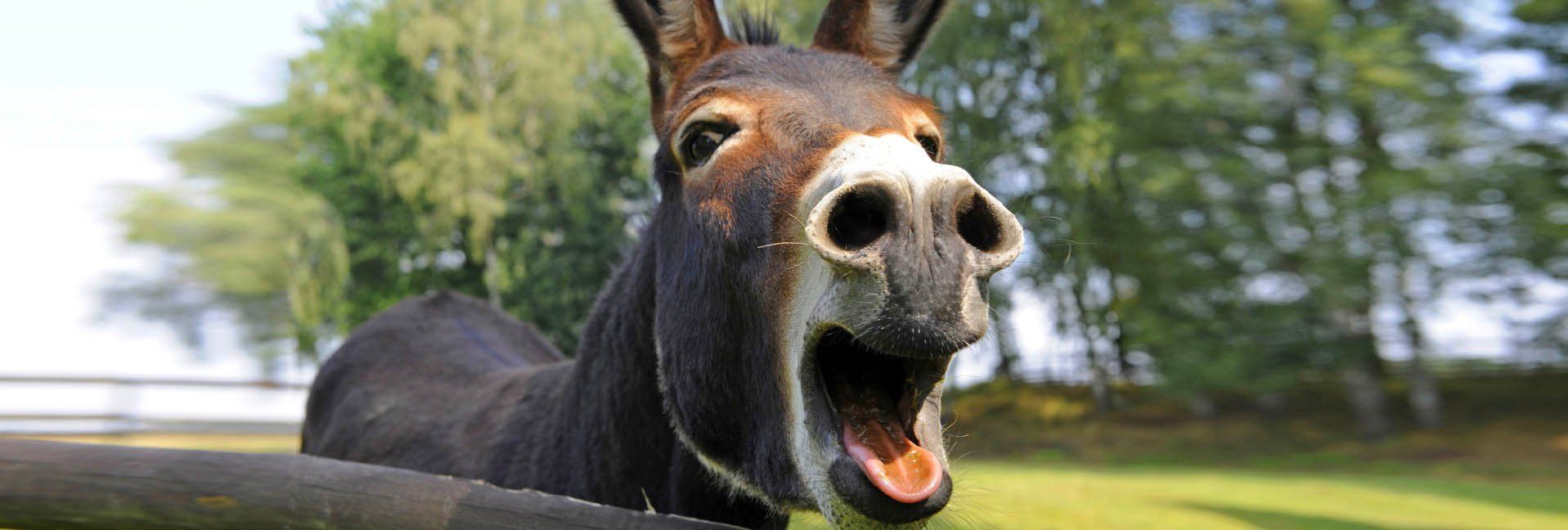Hee-Haw! Donkeys 101


Hee-haw! This unmistakable—and sometimes very loud—braying sound can only come from one of the equine family’s most charming members, the donkey. When you think of donkeys, you may conjure up the familiar image of a gold prospector leading a donkey loaded with mining tools, but there’s a lot more to donkeys than that.
Learn a little more about these fun animals with our quick list. For instance, did you know …?
Donkeys and humans have a long history together.
People around the world have been living and working with donkeys for thousands of years. While not the earliest livestock species to be domesticated—sheep, goats, and cattle were likely domesticated first—donkeys were nevertheless one of the earliest domesticated work animals. Exact dates are of course impossible to attain, but the donkey’s gradual domestication likely occurred earlier than 5000 years ago, probably in Africa, and these long-eared equines have been extremely valuable to humans ever since.
Images of donkeys appear carved on ancient Egyptian tombs showing the animals being used to carry loads. Their history is biblical, too—in the Book of Job, part of Job’s great wealth includes his 500 female donkeys.

Donkeys perform many jobs.
The donkey has proven so universally valuable partly because of its versatility and ease of care. Both today and in the past, donkeys have proven their use as a pack animal carrying loads over long distances or tricky terrain.
While sometimes too small to be ridden by adults, donkeys can be suitable as a mount under certain circumstances depending on the relative size of the rider and donkey. Donkeys are also frequently employed as draft animals, plowing fields and pulling carts. Donkey power has been used to draw water from wells, and donkeys are often pastured with other types of livestock to act as guardians (they’re good protection against coyotes). The donkey is truly a “jack” of all trades!
(That was a donkey joke, by the way. Keep reading to find out why.)
Donkeys are “easy keepers.”
Donkeys have a very efficient digestive system that processes food into energy more effectively than horses, and they can exist on lesser-quality forage or pasture. In fact, it’s easy to overfeed a donkey, and they often do just fine on grass hay. Donkeys are hardy animals, but are generally better suited to hot, dry regions than they are to cold locations.
Donkeys have long lifespans.
In the wild, it isn’t uncommon to see a donkey live to be 25 or even 30 years old. In a domestic situation however, it’s not unheard of for donkeys to live into their 40s or even to 50 years old.
The oldest alive today is said to be in his mid-50s, and the oldest ever reportedly lived into his 70s!
Donkeys are… not so stubborn?
“Why do you want a donkey? Donkeys are so stubborn!” Clichéd comments regarding donkeys are very common, but aren’t always accurate. Donkey behaviors that are frequently thought of as “stubborn” may actually be a misinterpretation of a donkey’s naturally cautious attitude.
Many prey animals like horses, deer, and sheep will shy, flee, or spook when confronting a new “scary” object or situation. Donkeys, however, take a different approach and usually prefer to to “wait and see.” Instead of running, a frightened donkey may stop and analyze the situation, waiting to see what happens next and refusing to make another move until he feels more at ease.
While sometimes frustrating to a donkey’s handler if he can’t figure out what is bothering his animal, this “stubborn” behavior is actually beneficial in some situations, such as when leading a donkey through narrow or difficult terrain. The key to overcoming “stubbornness” is to form a solid relationship with the donkey so that he has confidence in your guidance.
Donkeys come in many sizes.
There isn’t just one type of donkey. There are well over one hundred donkey breeds worldwide, with a great diversity of sizes, including the less-than-36-inch Miniature Mediterranean Donkey, the Standard and Large Standard Donkeys standing between 36 and 56 inches, and the Mammoth Stock Donkey, which is larger than 54 inches. And speaking of Mammoth Stock Donkeys, the tallest donkey in the world is a Mammoth Stock Donkey named “Romulus,” according to the Guinness World Records. Romulus is 68 inches—or 17 hands—tall. He even has his own Facebook page.
Donkeys are necessary for mules.
There are donkeys…and horses…and….mules, right? But how is a mule different from a donkey?
A mule is the offspring of a male donkey—a jack—and a mare (horse). Mules combine some of the most useful traits of both animals; strength and soundness from the donkey, speed and grace from the horse.
Another possible cross is the hinny—the offspring of a female donkey (called a jenny) and a stallion. Hinnies are less common than mules, but are very similar with only subtle physical differences. In either case, mules and hinnies are themselves unable to reproduce. This is because horses possess 64 chromosomes and donkeys 62; the resulting mule or hinny receives 63, and is infertile.
Are you ready to explore the fascinating world of donkeys? Join the fun!
Tags:Country Critters

Acreage Life is part of the Catalyst Communications Network publication family.














